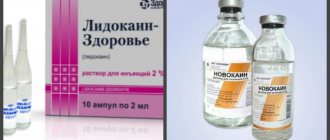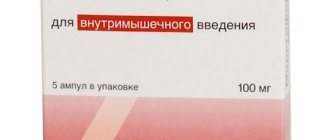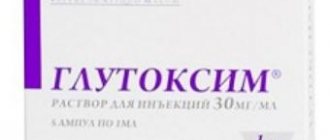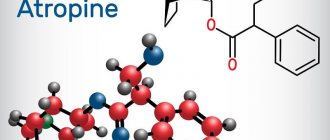Contraindications
hypersensitivity to pyrazolone derivatives (butadione, tribuzone);
bronchial asthma;
diseases accompanied by bronchospasm;
"aspirin asthma";
inhibition of hematopoiesis (agranulocytosis, neutropenia, leukopenia);
severe liver or kidney dysfunction;
blood diseases;
hereditary hemolytic anemia associated with deficiency of glucose-6-phosphate dehydrogenase;
pregnancy (especially in the first trimester and in the last 6 weeks);
lactation period.
With caution - infancy (up to 3 months).
Instructions:
Clinical and pharmacological groups
11.032 (Drug with m-anticholinergic, antacid and analgesic effects) 12.046 (Drug for symptomatic treatment of acute respiratory diseases) 03.009 (Analgesic-antipyretic) 03.012 (Spasmoanalgesic) 03.010 (Analgesic-antipyretic combined composition) 03.007 (Combined binary drug with analgesic effect)
pharmachologic effect
Analgesic-antipyretic. It is a derivative of pyrazolone. It has an analgesic, antipyretic and anti-inflammatory effect, the mechanism of which is associated with inhibition of prostaglandin synthesis.
Pharmacokinetics
After oral administration, metamizole sodium is rapidly hydrolyzed in gastric juice to form the active metabolite 4-methyl-amino-antipyrine, which, after absorption, is metabolized into 4-formyl-amino-antipyrine and other metabolites. After intravenous administration, metamizole sodium quickly becomes inaccessible for determination.
Metamizole sodium metabolites do not bind to plasma proteins. The largest portion of the dose is excreted in the urine in the form of metabolites. Metabolites are excreted in breast milk.
Dosage
Adults are prescribed 250-500 mg 2-3 times a day orally or rectally. The maximum single dose is 1 g, daily dose is 3 g. Single doses for children aged 2-3 years are 50-100 mg; 4-5 years - 100-200 mg; 6-7 years - 200 mg; 8-14 years - 250-300 mg; Frequency of administration: 2-3 times/day.
IM or IV slowly for adults - 250-500 mg 2-3 times a day. The maximum single dose is 1 g, the daily dose is 2 g. In children, it is used parenterally at a dose of 50-100 mg per 10 kg of body weight.
Drug interactions
When used simultaneously with analgesics-antipyretics and NSAIDs, mutual enhancement of toxic effects is possible.
When used simultaneously with inducers of microsomal liver enzymes, the effectiveness of metamizole sodium may decrease.
With simultaneous use, the activity of indirect anticoagulants, oral hypoglycemic drugs, corticosteroids, and indomethacin increases due to their displacement from connection with blood proteins under the influence of metamizole sodium.
When used simultaneously with phenothiazine derivatives, severe hyperthermia is possible; with sedatives, anxiolytics - the analgesic effect of metamizole sodium is enhanced; with tricyclic antidepressants, oral contraceptives, allopurinol - the metabolism of metamizole sodium is disrupted and its toxicity increases; with caffeine - the effect of metamizole sodium is enhanced; with cyclosporine - the concentration of cyclosporine in the blood plasma decreases.
When metamizole sodium is used in combination with pitofenone hydrochloride (has a direct myotropic effect on the smooth muscles of internal organs and causes its relaxation) and with fenpiverinium bromide (m-anticholinergic), their pharmacological action is mutually enhanced, which is accompanied by a decrease in pain, relaxation of smooth muscles and reduction of elevated body temperature.
Use during pregnancy and lactation
Use with caution during pregnancy, especially in the first trimester and in the last 6 weeks.
Side effects
Allergic reactions: skin rash, Quincke's edema; rarely - anaphylactic shock.
From the hematopoietic system: rarely, with long-term use - leukopenia, agranulocytosis.
Local reactions: with intramuscular injection - infiltrates at the injection site.
Indications
Pain syndrome of various origins (renal and biliary colic, neuralgia, myalgia; with injuries, burns, after operations; headache, toothache, menalgia). Fever in infectious and inflammatory diseases.
Contraindications
Severe renal and/or liver dysfunction, glucose-6-phosphate dehydrogenase deficiency, blood diseases, hypersensitivity to pyrazolone derivatives.
special instructions
With long-term use, it is necessary to monitor the peripheral blood picture.
Metamizole sodium is used in combination with pitofenone and fenpiverinium bromide as an analgesic with an antispasmodic effect.
Use with caution in children in the first 3 months of life.
Preparations containing METAMIZOLE SODIUM
• ANALGIN ◊ tab. 500 mg: 10 or 20 pcs. • ANALGIN solution for intravenous and intramuscular administration 250 mg/1 ml: amp. 10 pieces. • ANALGIN ◊ tab. 500 mg: 10 pcs. • PENTALGIN®-ICN (PENTALGIN-ICN) ◊ tablets: 6, 10, 12, 20 or 24 pcs. • ANDIPAL ◊ tab.: 10 pcs. • ANALGIN tablets 0.5 g (ANALGIN tablets 0.5) ◊ tab. 500 mg: 10 or 20 pcs. • ANALGIN ◊ tab. 500 mg: 10 or 20 pcs. • ANALGIN capsules 0.25 g (ANALGIN capsule 0.25) ◊ caps. 250 mg: 10 or 20 pcs. • BARALGETAS solution for intravenous and intramuscular administration 2.5 g+10 mg+100 mcg/5 ml: amp. 5 pieces. • ANALGIN-CHININ (ANALGIN-CHININ) ◊ tab., coated. film-coated, 200 mg+50 mg: 20 or 350 pcs. • ANALGIN ◊ tab. 500 mg: 10 or 20 pcs. • ANALGIN ◊ tab. 500 mg: 10 and 20 pcs. • ANALGIN solution for intravenous and intramuscular administration 500 mg/1 ml: amp. 10 pieces. • MAXIGAN solution for intravenous and intramuscular administration 2.5 g+10 mg+100 mcg/5 ml: amp. 5 pieces. • BENALGIN tab. 500 mg+50 mg+38.75 mg: 20 pcs. • SPASMALGON® ◊ tab. 500 mg+5 mg+100 mcg: 20 pcs. • ANDIPAL ◊ tab.: 10 pcs. • ANALGIN tablets 0.5 g (ANALGIN tablets 0.5) ◊ tab. 500 mg: 10 or 20 pcs. • ANDIPAL ◊ tab.: 10 pcs. • ANTIGRIPPIN-ORVI combination. pack (a set of capsules of two types), including:; caps. A yellow: 10 pcs.; caps. B white: 10 pcs. • ANDIPAL ◊ tab.: 10 pcs. • PENTALGIN®-N (PENTALGIN-N) ◊ tablet: 10 pcs. • ANALGIN ◊ sup. rect. for children 100 mg: 10 pcs. • ANALGIN tablets 0.5 g (ANALGIN tablets 0.5) ◊ tab. 500 mg: 10 or 20 pcs. • ANDIPAL ◊ tab.: 10 pcs. • NEBALGAN solution for injection. 1 g+4 mg+40 mcg/2 ml: amp. 10 pieces. • ANALGIN (ANALGIN) solution for intravenous and intramuscular administration 1 g/2 ml: amp. 10 pieces. • ANALGIN tablets 0.5 g (ANALGIN tablets 0.5) ◊ tab. 500 mg: 10 or 20 pcs. • ANALGIN (ANALGIN) solution for intravenous and intramuscular administration 1 g/2 ml: amp. 10 pieces. • ANALGIN ◊ tab. 500 mg: 10 pcs. • TEMPALGIN® ◊ tab., coated. shell: 20 or 100 pcs. • NEBALGAN ◊ tab. 500 mg+5 mg+100 mcg: 100 pcs. • ANALGIN (ANALGIN) solution for intravenous and intramuscular administration 1 g/2 ml: amp. 10 pieces. • ANALGIN tablets 0.5 g (ANALGIN tablets 0.5) ◊ tab. 500 mg: 10 or 20 pcs. • ANALGIN solution for injection. 25% (250 mg/1 ml): amp. 10 pieces. • ANALGIN solution for intravenous and intramuscular administration 1 g/2 ml: amp. 10 pieces. • ANALGIN ◊ sup. rect. for children 250 mg: 10 pcs. • BIORALGINE ◊ tab. 500 mg+5 mg+100 mcg: 50 pcs. • REVALGIN solution for injection. 2.5 g+10 mg+100 mcg/5 ml: amp. 3, 5, 6, 9, 10, 12, 15, 20, 25, 30, 40 or 50 pcs. • SPASMALGON® (SPASMALGON®) solution for intramuscular administration 1 g+40 mcg+4 mg/2 ml: amp. 10 pieces. • SPASMALIN® ◊ tab. 500 mg+5 mg+100 mcg: 4.10, 20 or 100 pcs. • SANTOPERALGIN tab. 10 or 20 pcs. • ANDIPAL tablets: 10, 20 or 50 pcs. • ANALGIN solution for injection. 50% (500 mg/1 ml): amp. 5 or 10 pcs. • ANALGIN ◊tab. 500 mg: 10 or 20 pcs. • ANALGIN solution for intravenous and intramuscular administration 500 mg/2 ml: amp. 10 pieces. • SEDAL-M® ◊ tablets: 10 or 20 pcs. • ANALGIN solution for injection. 25% (500 mg/2 ml): amp. 10 pieces. • REVALGIN solution for injection. 500 mg+2 mg+20 mcg/1 ml: amp. 3, 5, 6, 9, 10, 12, 15, 20, 25, 30, 40 or 50 pcs. • ANALGIN ◊ tab. 500 mg: 10 pcs., cans 20 and 30 pcs. • ANALGIN solution for intravenous and intramuscular administration 500 mg/1 ml: amp. 10 pieces. • SPASGAN solution for intravenous and intramuscular administration 2.5 g+10 mg+100 mcg/5 ml: amp. 5 or 25 pcs. • ANALGIN-UBF (ANALGIN-UBF) ◊ tab. 500 mg: 10, 20, 30, 40, 50 and 60 pcs. • BELLALGIN ◊ tablets: 10, 30 or 50 pcs. • PENTABUFEN tab. 10 or 20 pcs. • ANDIPAL ◊ tab.: 10 pcs. • BELLALGIN ◊ tablets: 10, 30 or 50 pcs. • ANALGIN ◊ tab. 500 mg: 20 or 30 pcs. • SEDALGIN-NEO® (SEDALGIN-NEO®) ◊ tablet: 5 or 10 pcs. • ANALGIN solution for injection. 50% (1 g/2 ml): amp. 10 pieces. • ANALGIN (ANALGIN) solution for intravenous and intramuscular administration 1 g/2 ml: amp. 5 or 10 pcs. • BRALANGINE ◊ tab. 500 mg+5 mg+100 mcg: 10, 20 or 100 pcs. • ANDIPAL ◊ tab.: 10 or 20 pcs. • ANALGIN tablets 0.5 g (ANALGIN tablets 0.5) ◊ tab. 500 mg: 10 or 20 pcs. • ANDIPAL ◊ tab.: 10 pcs. • ANDIPAL ◊ tab.: 10 pcs. • BRAL ◊ solution for intravenous and intramuscular administration of 2.5 g+10 mg+10 mcg/5 ml: amp. 5 pieces. • ANALGIN (ANALGIN) solution for intravenous and intramuscular administration 1 g/2 ml: amp. 10 pieces. • ANALGIN capsules 0.25 g (ANALGIN capsule 0.25) ◊ caps. 250 mg: 10 or 20 pcs. • BELLALGIN ◊ tablets: 10, 30 or 50 pcs. • RENALGAN ◊ tab. 500 mg+5 mg+100 mcg: 10 pcs. • TETRALGIN tablets: 10 or 20 pcs. • ANALGIN tablets 0.5 g (ANALGIN tablets 0.5) ◊ tab. 500 mg: 10 or 20 pcs. • ANALGIN solution for intravenous and intramuscular administration 500 mg/1 ml: amp. 10 pieces. • ANALGIN tablets 0.5 g (ANALGIN tablets 0.5) ◊ tab. 500 mg: 10 or 20 pcs. • SPASGAN ◊ tab. 500 mg+5 mg+100 mcg: 20 or 100 pcs. • ANDIPAL ◊ tab.: 10 pcs. • ANALGIN ◊ tab. 500 mg: 10 pcs. • ANALGIN tablets 0.5 g (ANALGIN tablets 0.5) ◊ tab. 500 mg: 10 or 20 pcs. • ANDIPAL ◊ tab.: 10 pcs. • ANALGIN (ANALGIN) solution for intravenous and intramuscular administration 1 g/2 ml: amp. 10 pieces. • ANALGIN (ANALGIN) solution for intravenous and intramuscular administration 1 g/2 ml: amp. 10 or 100 pcs. • ANALGIN solution for intravenous and intramuscular administration 500 mg/1 ml: amp. 10 pieces. • ANALGIN capsules 0.25 g (ANALGIN capsule 0.25) ◊ caps. 250 mg: 10 or 20 pcs. • ANALGIN tablets 0.5 g (ANALGIN tablets 0.5) ◊ tab. 500 mg: 10 or 20 pcs. • ANDIPAL ◊ tab.: 10 or 20 pcs. • ANALGIN BUFUS solution for intravenous and intramuscular administration 1 g/2 ml: amp. 10 pieces. • ANALGIN solution for intravenous and intramuscular administration 500 mg/1 ml: amp. 10 pieces. • ANALGIN tablets 0.5 g (ANALGIN tablets 0.5) ◊ tab. 500 mg: 10 or 20 pcs. • ANTIGRIPPIN-ANVI® (ANTIGRIPPIN-ANVI) ◊ caps. (two types): 20 pcs.1 • SANTOTITRALGIN ◊ tab. 10 pieces. • ANALGIN tablets 0.5 g (ANALGIN tablets 0.5) ◊ tab. 500 mg: 10 or 20 pcs. • BRALANGINE solution for injection. 2.5 g+10 mg+100 mcg/5 ml: amp. 5 or 10 pcs. • ANDIPAL ◊ tab.: 10 pcs. • ANALGIN solution for intravenous and intramuscular administration 250 mg/1 ml: amp. 10 pieces. • SPASMALIN® solution for injection. 2.5 g+10 mg+100 mcg/5 ml: amp. 5 or 25 pcs. • MAXIGAN ◊ tab. 500 mg+5 mg+100 mcg: 10, 20 or 100 pcs. • ANALGIN ◊ tab. 500 mg: 10 pcs. • NEBALGAN solution for injection. 2.5 g+10 mg+100 mcg/5 ml: amp. 5 pieces. • ANALGIN (ANALGIN) solution for intravenous and intramuscular administration 1 g/2 ml: amp. 10 pieces. • ANALGIN solution for intravenous and intramuscular administration 250 mg/1 ml: amp. 10 pieces. • ANDIPAL tablets: 10 or 20 pcs. • ANALGIN tablets 0.5 g (ANALGIN tablets 0.5) ◊ tab. 500 mg: 10 or 20 pcs. • REVALGIN ◊ tab. 500 mg+5 mg+100 mcg: 10, 20, 30, 40, 50, 60, 80, 100 or 200 pcs. • ANALGIN tablets 0.5 g (ANALGIN tablets 0.5) ◊ tab. 500 mg: 10 or 20 pcs. • ANALGIN solution for injection. 50% (500 mg/1 ml): amp. 10 pieces. • ANDIPAL ◊ tab.: 10 pcs. • REVALGIN solution for injection. 1 g+4 mg+40 mcg/2 ml: amp. 3, 5, 6, 9, 10, 12, 15, 20, 25, 30, 40 or 50 pcs. • ANALGIN solution for intravenous and intramuscular administration 500 mg/2 ml: amp. 10 pieces. • BELLALGIN ◊ tablets: 10, 30 or 50 pcs. • QUINTALGINE ◊ tablet: 10 pcs. • ANALGIN tablets 0.5 g (ANALGIN tablets 0.5) ◊ tab. 500 mg: 10 or 20 pcs. • ANALGIN tablets 0.5 g (ANALGIN tablets 0.5) ◊ tab. 500 mg: 10 or 20 pcs. • ANALGIN tablets 0.5 g (ANALGIN tablets 0.5) ◊ tab. 500 mg: 10 or 20 pcs. • TEMPANGINOL® ◊ tab., coated. casing: 10, 20, 300 or 1000 pcs. • BIORALGIN ◊ tab. 500 mg+5 mg+100 mcg: 10, 20 or 100 pcs. • BELLALGIN ◊ tablets: 10, 20 or 30 pcs. • ANALGIN (ANALGIN) solution for intravenous and intramuscular administration 500 mg/1 ml: amp. 5 or 10 pcs. • BELLALGIN ◊ tablet: 10 or 20 pcs. • ANDIPAL ◊ tab.: 10 pcs. • ANALGIN tablets 0.5 g (ANALGIN tablets 0.5) ◊ tab. 500 mg: 10 or 20 pcs. • ANALGIN ◊ tab. 500 mg: 10 pcs. • ANALGIN ◊ tab. 500 mg: 10 or 20 pcs. • ANALGIN ◊ tab. 500 mg: 20 or 500 pcs. • ANTIGRIPPIN-ANVI® (ANTIGRIPPIN-ANVI) ◊ caps. (two types): 20 pcs. • PLENALGIN solution for injection. 2.5 g+10 mg+100 mcg/5 ml: amp. 5 pieces. • ANALGIN ◊ tab. 500 mg: 10 pcs. • ANALGIN ◊ tab. 500 mg: 10 or 20 pcs. • BARALGETAS ◊ tab. 500 mg+5 mg+100 mcg: 10 or 100 pcs. • ANALGIN ◊ tab. 500 mg: 20 pcs. • PYRALGIN ◊ tablets: 10 or 20 pcs. • BRAL ◊ tab. 500 mg+5 mg+100 mcg: 20 or 100 pcs. • SPASMALGON® (SPASMALGON®) solution for intramuscular administration 2.5 g+100 mcg+10 mg/5 ml: amp. 10 pieces. • BARALGIN® M (BARALGIN M) solution for intravenous and intramuscular administration 2.5 g/5 ml: amp. 5 pieces. • ANALGIN solution for intravenous and intramuscular administration 500 mg/2 ml: amp. 10 pieces. • ANALGIN-ULTRA (ANALGIN-ULTRA) ◊ tab., coated. film coating, 500 mg: 5, 10 or 20 pcs. • ANDIPAL ◊ tab.: 10 or 20 pcs. • BELLALGIN ◊ tablets: 10, 30 or 50 pcs. • ANALGIN ◊ tab. 500 mg: 10 pcs. • ANALGIN tablets 0.5 g (ANALGIN tablets 0.5) ◊ tab. 500 mg: 10 or 20 pcs. • ANALGIN solution for injection. 50% (1 g/2 ml): amp. 5 or 10 pcs. • BARALGIN® M (BARALGIN M) tab. 500 mg: 10, 20, 50 or 100 pcs. • ANALGIN ◊ tab. 500 mg: 10, 20 and 30 pcs.
Side effects
Allergic reactions: skin rash, Quincke's edema; rarely - anaphylactic shock, toxic epidermal necrolysis (Lyell's syndrome), in rare cases - Stevens-Johnson syndrome.
With prolonged use, leukopenia, thrombocytopenia, and agranulocytosis may occur.
If you are prone to bronchospasm, it is possible to provoke an attack; decrease in blood pressure.
Possible renal dysfunction, oliguria, anuria, proteinuria, interstitial nephritis, red staining of urine due to the release of a metabolite.
About all side (unusual) effects, incl. not listed above, you should inform your doctor and stop taking the drug.
Interaction
The simultaneous use of Analgin with other non-narcotic analgesics can lead to mutual enhancement of toxic effects.
Tricyclic antidepressants, oral contraceptives and allopurinol interfere with the metabolism of metamizole in the liver and increase its toxicity.
Barbiturates and phenylbutazone weaken the effect of analgin.
Analgin enhances the effects of alcohol-containing drinks.
Radiocontrast agents, colloidal blood substitutes and penicillin should not be used during treatment with metamizole.
Metamizole, displacing oral hypoglycemic drugs, indirect anticoagulants, corticosteroids and indomethacin from protein binding, increases their activity.
The simultaneous use of Analgin with cyclosporine reduces the level of the latter in the blood. Thiamazole and sarcolysine increase the risk of developing leukopenia. The effect is enhanced by codeine and propranolol (slows down inactivation).
Sedatives and tranquilizers enhance the analgesic effect of analgin.
Preparations containing (Metamizole Sodium analogues)
Level 4 ATC code matches:
Antipyrine
Analdim
Reopirin
Tempalgin
Benalgin
Pentalgin ICN
Pentalgin N
Pentalgin
Analgin
Tetralgin
Spasmalin
Maxigan
Sedal-M
Piralgin
Baralgin M
Sedalgin Plus
Revalgin
Andipal
Analogues (trade names) of medicines: Analgin , Optalgin , Analgin solution in ampoules , Analgin-Ultra , Spazdolzin for children , Baralgin M , Analgin Avexima and so on.
The combination of Metamizole Sodium + fenpiverinium bromide + pitofenone . Drugs of this kind are considered more effective. Trade names Metamizole Sodium, pitofenone , fenpiverinium bromide : Spazmalgon , Spazmalin , Revalgin , Baralgetas , Trinalgin , Plenalgin , Renalgan , Spazmofarm , Spazgan , Bral , Maksigan , Bralangin , Spasmaton and so on.
Directions for use and doses
Inside, adults - 1 tablet. 2-3 times a day after meals. The maximum single dose is 1 g (2 tablets), daily dose is 3 g (6 tablets). With long-term (more than a week) use of the drug, monitoring of the peripheral blood picture and the functional state of the liver is necessary.
Children are prescribed 5–10 mg/kg body weight 3–4 times a day for no more than 3 days (after crushing the tablet).
Do not use (without consulting a doctor) for more than 3 days when prescribed as an antipyretic and for more than 5 days when prescribed as an analgesic.
Overdose
Symptoms: with long-term use of the drug (more than 7 days) in large doses - nausea, vomiting, gastralgia, oliguria, hypothermia, decreased blood pressure, tachycardia, shortness of breath, tinnitus, drowsiness, delirium, disturbances of consciousness, agranulocytosis, hemorrhagic syndrome, acute renal and/or liver failure, convulsions, paralysis of the respiratory muscles.
Treatment: induce vomiting, perform gastric lavage, take saline laxatives, activated charcoal. In a medical institution - forced diuresis, hemodialysis, with the development of convulsive syndrome - intravenous administration of diazepam and barbiturates.
special instructions
Patients suffering from bronchial asthma and hay fever may develop hypersensitivity reactions.
With long-term use (more than 7 days), it is necessary to monitor the peripheral blood picture.
Do not use to relieve acute abdominal pain (until the causes are clarified).
When treating children under 5 years of age and patients receiving cytotoxic drugs, metamizole sodium should only be taken under medical supervision.
Particular caution is required when prescribing to patients who abuse alcoholic beverages.
Children under 2 years of age are recommended to use pediatric dosage forms.
For children and adolescents under 18 years of age, use only as prescribed by a doctor.
Chemical properties
Metamizole Sodium is a drug, antipyretic , analgesic , belongs to the group of pyrazolones . The substance was synthesized back in 1920. Since the 70s, due to the risk of developing agranulocytosis, the medicine began to be excluded from sale in some European countries, Sweden, Australia, and Japan. At the moment, the product is sold strictly according to prescription. In the Russian Federation in 2009 it was removed from the list of vital and essential drugs. Metamizole sodium is commercially available. The substance was assigned OKPD code 24.42.13.673.
According to its physical properties, the medicine is a white or white-yellow crystalline powder that quickly decomposes at high humidity. The product is highly soluble in water, the pH of the finished solution is from 6 to 7.5. Poorly soluble in alcohol, practically insoluble in acetone , ether and chloroform . Molecular weight of Metamizole = 311.4 grams per mole; Metamizole sodium – 333.3 grams per mole. The chemical compound is given in the form of tablets, suppositories, drops and injection solution.







